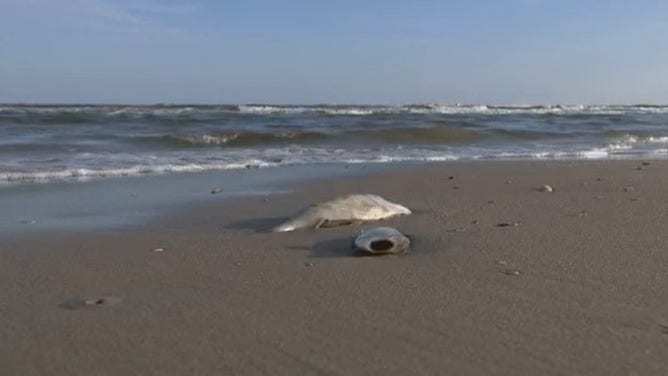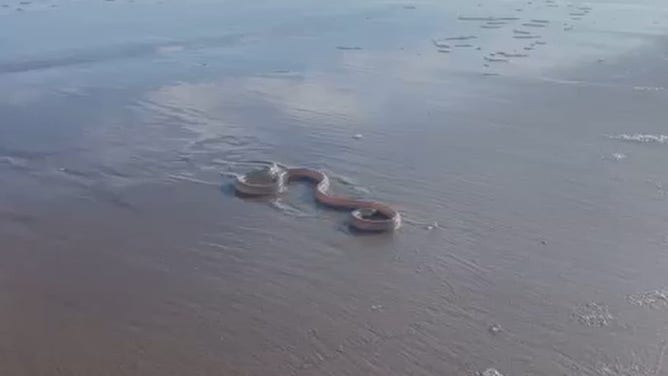Thousands of dead fish along the Texas Gulf Coast; red tide algae confirmed to be the cause
A red tide algae bloom is killing fish. The same algae can cause respiratory issues in humans. Do not eat raw shellfish during red tide, it could be deadly.
Dead fish, sea snakes and sharks washing up on Texas coast: Red tide
Officials concluded that red tide is to blame for the recent Texas fish kill, resulting in thousands of dead fish, sharks and snakes washing onto the beach. Humans feel the impact too. FOX 26 Matthew Seedorff talks to beachgoers and a Texas Parks and Wildlife official.
BRAZORIA COUNTY, Texas - Red tide algae has been confirmed along the Texas Coast and is causing thousands of fish to wash up dead onshore.
Swimmers at Quintana Beach Monday in Brazoria County immediately noticed dead fish scattered across the beach.
"It’s one big, long graveyard all the way down the shore on Quintana Beach," said Luis Angel.

Thousands of dead fish have washed up on Texas beaches.
(FOX 26 Houston)
According to Texas Parks and Wildlife Department (TPWD), the presence of red tide on the upper coast was first confirmed at a red tide monitoring station near Freeport about 3 weeks ago. Since then, low to moderate concentrations of red tide have been detected near Freeport and the Texas City Dike. In addition, the bloom is suspected to be responsible for killing thousands of fish at San Luis Pass, Surfside Beach, and the Quintana/Freeport Channel.
"This will get most fish nearby," said Bryan Frazier, Parks Director for Brazoria County. "We’re seeing some dead sharks and other fish wash on shore."
Red tide is naturally occurring, deadly to fish, irritant to humans
The microalgae that cause red tide (Karenia brevis) is a naturally occurring organism that produces a toxin affecting the central nervous system of fish, causing paralysis and the inability to breathe. As a result, red tide blooms often result in dead fish washing up on Gulf beaches. When red tide algae reproduce in dense concentrations or "blooms," they are visible as discolored patches of water, often reddish in color.
FLORIDA PREPARES FOR MANATEES SUFFERING FROM RED TIDE

Beachcombers not only come across dead carcasses but feel allergy or flu-like symptoms themselves.
(FOX 26 Houston)
"These toxins can actually aerosolize," said Frazier. "They’ll get up into the air. You’ll see people with sinus issues, sneezing, and coughing."
Beachgoers at Quintana Monday say they immediately noticed something unusual in the air.
"Once we opened the door to the car, everybody started coughing and sneezing," said Celeste Lopez.
"The moment we got out of the car, [we] started coughing and sneezing," said Angel. "It was very noticeable."
People who are near the water during red tide may experience irritation of the eyes, nose and throat, as well as coughing, wheezing and shortness of breath. People with an existing respiratory illness, such as asthma, may experience these symptoms more severely. If you have concerns or questions about human health effects of red tide or symptoms you are experiencing, consult a physician.
VIDEO SHOWS HUNDREDS OF DEAD FISH SCATTERED ALONG FLORIDA BEACH

Snakes and sharks have been washing up too.
(FOX 26 Houston)
Texas was last impacted by a red tide in 2018 which occurred along the upper and middle coast of the state.
Can I go to the beach during red tide?
Officials say it’s still safe to eat fish caught during a red tide. However, the same can’t be said about oysters. In addition, the dead sea life found along the beach during a red tide can be hazardous to eat.
Experts aren’t sure how long the red tide will impact Texas beaches but believe it’s moving southwest.
